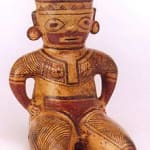Terracotta Polychrome Seated Female Figure, 500 CE - 1550 CE
Terracotta
PF.3845
The stylized female figures produced in the Guanacaste-Nicoya Zone underwent a slow evolutionary change over the centuries; yet managed to retain a flair for extraordinary detail, intricate designs and vibrant...
The stylized female figures produced in the Guanacaste-Nicoya Zone underwent a slow evolutionary change over the centuries; yet managed to retain a flair for extraordinary detail, intricate designs and vibrant color. This superb seated female exhibits the characteristic wide, flat head (which may be a result of cranial deformation), and high turban or headdress of the Mora Polychrome style. She is covered in very carefully drawn patterns probably representing tattooing or scarification. The simple painting on the face gives the impression of a mask, especially with the broad almond-shaped black lines around her eyes. She wears large earspools and a loincloth that barely covers her waist. The positioning of her hands placed on the hips is typical of such figures. Though her body posture is rigid, she is nonetheless quite welcoming, as if giving an 'audience' to her devotees. It is possible she represents the shaman-priest of a village, who occupied a very influential position, and therefore would account for her elaborate decoration and ornamentation. We can certainly say she was someone of importance, either a real human being or an idealized type, who is as proud and beautiful today as she was hundreds of years ago.



